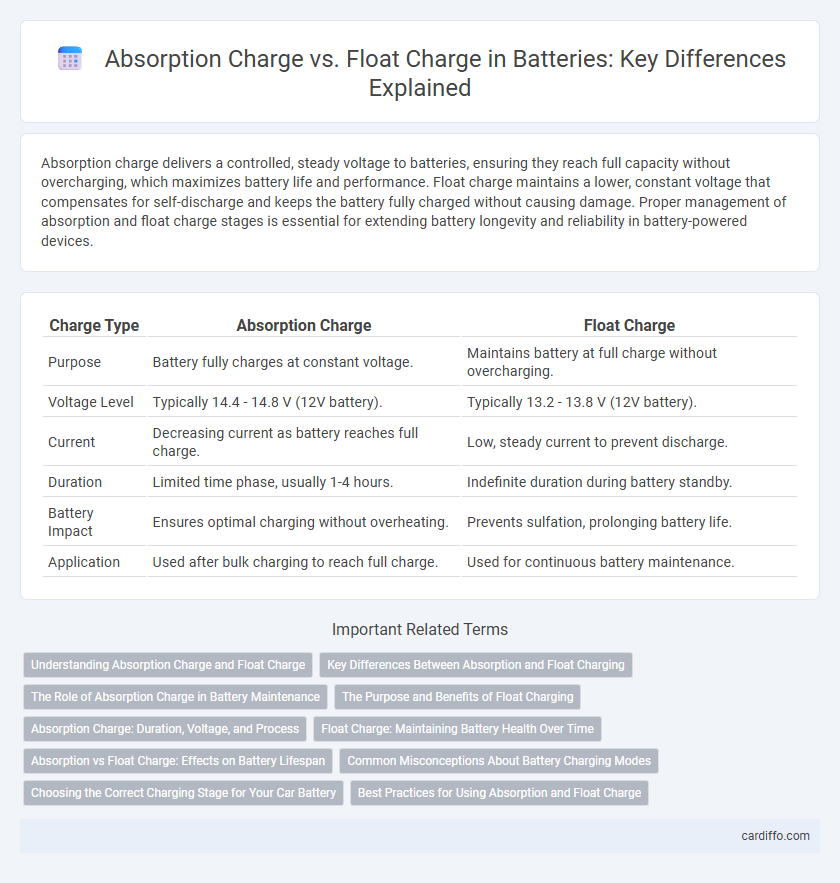Absorption charge delivers a controlled, steady voltage to batteries, ensuring they reach full capacity without overcharging, which maximizes battery life and performance. Float charge maintains a lower, constant voltage that compensates for self-discharge and keeps the battery fully charged without causing damage. Proper management of absorption and float charge stages is essential for extending battery longevity and reliability in battery-powered devices.
Table of Comparison
| Charge Type | Absorption Charge | Float Charge |
|---|---|---|
| Purpose | Battery fully charges at constant voltage. | Maintains battery at full charge without overcharging. |
| Voltage Level | Typically 14.4 - 14.8 V (12V battery). | Typically 13.2 - 13.8 V (12V battery). |
| Current | Decreasing current as battery reaches full charge. | Low, steady current to prevent discharge. |
| Duration | Limited time phase, usually 1-4 hours. | Indefinite duration during battery standby. |
| Battery Impact | Ensures optimal charging without overheating. | Prevents sulfation, prolonging battery life. |
| Application | Used after bulk charging to reach full charge. | Used for continuous battery maintenance. |
Understanding Absorption Charge and Float Charge
Absorption charge is a critical phase in battery charging where the voltage is held constant while the current gradually decreases, allowing the battery to reach full capacity without overcharging. Float charge maintains the battery at a steady voltage after full charge, compensating for self-discharge and ensuring long-term battery health. Understanding the distinction between absorption charge and float charge helps optimize battery lifespan and performance, especially in lead-acid and lithium-ion battery systems.
Key Differences Between Absorption and Float Charging
Absorption charge delivers a higher voltage to fully charge the battery by compensating for internal resistance and heating, typically ending when the battery reaches about 80-90% capacity. Float charge maintains a lower, steady voltage to keep the battery at full charge without overcharging, ideal for long-term maintenance and preventing self-discharge. The key difference lies in absorption's role to complete charging rapidly and float's function to sustain the charge safely over time.
The Role of Absorption Charge in Battery Maintenance
Absorption charge plays a critical role in battery maintenance by ensuring the battery reaches full capacity without overcharging, which prevents damage and prolongs battery life. During this phase, the charger provides a steady voltage while the current gradually decreases, allowing the battery to stabilize and complete the chemical reactions inside the cells. Proper absorption charging optimizes the battery's energy storage efficiency and maintains its overall health, especially in lead-acid and deep-cycle batteries.
The Purpose and Benefits of Float Charging
Float charging maintains a battery at full charge by supplying a steady, low-level voltage that compensates for self-discharge without causing overcharge damage. This method extends the battery's lifespan and ensures immediate readiness by preventing sulfation and electrolyte stratification. Float charging is essential in standby power systems, emergency backup, and renewable energy storage where reliable, long-term battery maintenance is critical.
Absorption Charge: Duration, Voltage, and Process
Absorption charge typically occurs at a voltage between 14.4 to 14.8 volts and lasts for about 1 to 3 hours, depending on the battery type and capacity. During this stage, the charging current gradually decreases while the voltage remains constant, allowing the battery to reach full capacity without overheating. This controlled process maximizes battery life by preventing overcharging and ensuring all cells are fully charged.
Float Charge: Maintaining Battery Health Over Time
Float charge maintains battery health by supplying a continuous low-level voltage that counteracts self-discharge without overcharging. This charging method stabilizes the battery's voltage, preserving electrolyte balance and preventing excess gassing or thermal stress. Consistent float charging extends battery life and ensures readiness for immediate use in standby applications.
Absorption vs Float Charge: Effects on Battery Lifespan
Absorption charge maintains a higher voltage to fully charge the battery, preventing sulfation and maximizing capacity without overcharging, which leads to a longer battery lifespan. Float charge uses a lower voltage to keep the battery at full charge without causing stress or overheating, preserving battery health during extended standby periods. Optimizing between absorption and float charge phases significantly reduces battery degradation and enhances overall service life.
Common Misconceptions About Battery Charging Modes
Absorption charge maintains a higher voltage to fully saturate battery cells without overcharging, while float charge provides a lower, steady voltage to keep the battery at full capacity. Many mistakenly believe that switching immediately from bulk to float prevents damage, but improper timing can still lead to undercharging or battery sulfation. Understanding the correct transition between absorption and float modes is essential for maximizing battery lifespan and performance.
Choosing the Correct Charging Stage for Your Car Battery
Absorption charge delivers a controlled voltage to safely replenish the majority of the car battery's capacity without overheating, making it ideal after bulk charging. Float charge maintains a lower, steady voltage to keep the battery at full capacity without overcharging, preserving battery health during extended periods of inactivity. Selecting the correct charging stage ensures optimal battery lifespan and performance by balancing effective energy delivery and avoiding damage from overcharging.
Best Practices for Using Absorption and Float Charge
Absorption charge maintains a battery at nearly full charge by providing a constant voltage while reducing current, preventing overcharging and maximizing battery life in lead-acid and lithium-ion systems. Float charge supplies a lower, steady voltage to keep the battery fully charged without causing damage from overcharging, ideal for long-term maintenance in standby power applications. Best practices include initiating absorption charge until current drops to 3-5% of battery capacity, then switching to float charge to avoid sulfation and ensure battery readiness.
Absorption Charge vs Float Charge Infographic

 cardiffo.com
cardiffo.com